Spectral Analysis, Biocompounds, and Physiological Assessment of Cork Oak Leaves: Unveiling the Interaction with Phytophthora cinnamomi and Beyond
Abstract
:1. Introduction
2. Materials and Methods
2.1. Biological Material
2.2. Leaf Optical Properties Measurements
2.3. Calculation of the Vegetative Indices
2.4. Leaf Gas Exchange Measurements
2.5. Quantification of Biochemical Parameters
3. Results and Discussion
3.1. Global Remarks on the Spectra Acquisition and Preprocessing
- Signal-to-noise ratio
- Experimental motivation for the choice of preprocessing
- (i)
- The inoculated plants have regained their initial structural integrity;
- (ii)
- The control plants have also experienced structural change.
- (i)
- Variations in pigment content between the two groups;
- (ii)
- Structural changes in leaf anatomy altering the light path to and from the chloroplasts, thereby impacting reflectance levels.
- The pigments’ content is similar in both the control and inoculated groups;
- The spongy mesophyll of the control group underwent alterations during the summer and acquired a structure similar to that of the inoculated group;
- The upper epidermal layer and/or the palisade mesophyll experienced differential changes between the control and inoculated groups, resulting in distinct responses in the visible range.
- Vegetation Indices
- PARAFAC analysis
3.2. Leaf Gas Exchange Measurements
3.3. Variation Pattern of Physiological Parameters and Biochemical Parameters
4. Conclusions
- 1.
- At 63 DAI, slight changes in the mesophyll, primarily influenced by water content, are observed. These subtle differences are predominantly detected at the red edge around 750 nm;
- 2.
- By 78 and 91 DAI, clear differentiation between the control and inoculated groups becomes apparent, particularly concerning the water bands. The variations in water content contribute significantly to the distinguishable patterns observed;
- 3.
- At 126 DAI, the impact of water content changes extends throughout the entire mesophyll structure. This is evidenced by a broad range in the NIR region where reflectance differences are observed;
- 4.
- At 248 DAI, following the summer season, the pigments’ content remains similar between the control and inoculated groups. However, distinct alterations in the leaf structure become evident, leading to the following observations:
- (a)
- The spongy mesophyll of the control group undergoes changes that render it structurally similar to that of the inoculated group;
- (b)
- Differential changes occur in the upper epidermal layer and/or the palisade mesophyll between the control and inoculated groups, resulting in differentiated responses in the visible range.
- 5.
- Several vegetation indices exhibit the capability to detect the infection, particularly those related to water content, such as WI (100% success rate) and WBI (80% success rate). Additionally, O1 (or WDVI) achieves a 70% success rate, which may indicate sensitivity to structural changes in the leaves caused by the infection. Interestingly, the widely used NDVI parameter proves to be almost ineffective in detecting the infection, with only a 10% success rate. This emphasizes the importance of considering specific vegetation indices tailored to the target application, as different indices capture different aspects of plant health and physiological changes;
- 6.
- The PARAFAC analysis on derivative spectra provided further confirmation of the conclusions derived from the direct spectral analysis and the vegetation indices. It revealed two factors, F1 and F2, which represent different directions of variation in the data. F1 captures the natural physiological variations within the leaves and is primarily influenced by changes in pigment bands in the visible spectrum. On the other hand, F2 is associated with the differences between the control and inoculated plants and is predominantly determined by variations in water content and leaf structural changes, as reflected in the NIR plateau region of the spectra. These findings align with the previous observations and highlight the distinct contributions of pigments and water/structural changes in discriminating between the control and inoculated plants.
Author Contributions
Funding
Institutional Review Board Statement
Informed Consent Statement
Data Availability Statement
Conflicts of Interest
References
- 6.° Inventário Florestal Nacional—IFN6, Relatório Final; ICNF (Instituto da Conservação da Natureza e das Florestas): Lisboa, Portugal, 2015.
- Acácio, V.; Dias, F.S.; Catry, F.X.; Bugalho, N.; Moreira, F. Canopy Cover Loss of Mediterranean Oak Woodlands: Long-term Effects of Management and Climate. Ecosystems 2021, 24, 1775–1791. [Google Scholar] [CrossRef]
- Bento, V.A.; Russo, A.; Vieira, I.; Gouveia, C.M. Identification of forest vulnerability to droughts in the Iberian Peninsula. Theor. Appl. Climatol. 2023, 152, 559–579. [Google Scholar] [CrossRef]
- Duque-Lazo, J.; Navarro-Cerrillo, R.M.; van Gils, H.; Groen, T.A. Forecasting oak decline caused by Phytophthora cinnamomi in Andalusia: Identification of priority areas for intervention. For. Ecol. Manag. 2018, 417, 122–136. [Google Scholar] [CrossRef]
- Aubard, V.; Paulo, J.A.; Silva, J.M.N. Long-Term Monitoring of Cork and Holm Oak Stands Productivity in Portugal with Landsat Imagery. Remote Sens. 2019, 11, 525. [Google Scholar] [CrossRef]
- Serrano, M.S.; Rios, P.; Gonzalez, M.; Sánchez, M.E. Experimental minimum threshold for Phytophthora cinnamomi root disease expression on Quercus suber. Phytopathol. Mediterr. 2015, 54, 461–464. [Google Scholar] [CrossRef]
- Moreira, A.C.; Martins, J.M.S. Influence of site factors on the impact of Phytophthora cinnamomi in cork oak stands in Portugal. For. Pathol. 2005, 35, 145–162. [Google Scholar] [CrossRef]
- Gómez-Aparicio, L.; Ibáñez, B.; Serrano, M.S.; De Vita, P.; Ávila, J.M.; Pérez-Ramos, I.M.; García, L.V.; Sánchez, M.E.; Marañón, T. Spatial patterns of soil pathogens in declining Mediterranean forests: Implications for tree species regeneration. New Phytol. 2012, 194, 1014–1024. [Google Scholar] [CrossRef]
- Matías, L.; Abdelaziz, M.; Godoy, O.; Gómez-Aparicio, L. Disentangling the climatic and biotic factors driving changes in the dynamics of Quercus suber populations across the species’ latitudinal range. Divers. Distrib. 2019, 25, 524–535. [Google Scholar] [CrossRef]
- Serrano, M.; Romero, M.A.; Homet, P.; Gómez-Aparicio, L. Climate change impact on the population dynamics of exotic pathogens: The case of the worldwide pathogen Phytophthora cinnamomi. Agric. For. Meteorol. 2022, 322, 109002. [Google Scholar] [CrossRef]
- Cardillo, E.; Abad, E.; Meyer, S. Iberian oak decline caused by Phytophthora cinnamomi: A spatiotemporal analysis incorporating the effect of host heterogeneities at landscape scale. For. Pathol. 2021, 51, e12667. [Google Scholar] [CrossRef]
- Bauriegel, E.; Giebel, A.; Geyer, M.; Schmidt, U.; Herppich, W.B. Early detection of Fusarium infection in wheat using hyper-spectral imaging. Comput. Electron. Agric. 2011, 75, 304–312. [Google Scholar] [CrossRef]
- Ustin, S.L.; Jacquemoud, S. How the optical properties of leaves modify the absorption and scattering of energy and enhance leaf functionality. In Remote Sensing of Plant Biodiversity; Springer International Publishing: Cham, Switzerland, 2020; pp. 349–384. [Google Scholar] [CrossRef]
- Slaton, M.R.; Raymond Hunt, E., Jr.; Smith, W.K. Estimating near-infrared leaf reflectance from leaf structural characteristics. Am. J. Bot. 2001, 88, 278–284. [Google Scholar] [CrossRef] [PubMed]
- Gausman, H.W.; Allen, W.A. Optical parameters of leaves of 30 plant species. Plant Physiol. 1993, 52, 57–62. [Google Scholar] [CrossRef] [PubMed]
- Dawson, T.P.; Curran, P.J. Technical note: A new technique for interpolating the reflectance red edge position. Int. J. Remote Sens. 1998, 19, 2133–2139. [Google Scholar] [CrossRef]
- Franke, J.; Menz, G. Multi-temporal wheat disease detection by multi-spectral remote sensing. Precis. Agric. 2007, 8, 161–172. [Google Scholar] [CrossRef]
- Buitrago, M.F.; Groen, T.A.; Hecker, C.A.; Skidmore, A.K. Spectroscopic determination of leaf traits using infrared spectra. Int. J. Appl. Earth Obs. Geoinf. 2018, 69, 237–250. [Google Scholar] [CrossRef]
- Kuska, M.T.; Brugger, A.; Thomas, S.; Wahabzada, M.; Kersting, K.; Oerke, E.-C.; Steiner, U.; Mahlein, A.-K. Spectral Patterns Reveal Early Resistance Reactions of Barley Against Blumeria graminis f. sp. hordei. Phytopathology 2017, 107, 1388–1398. [Google Scholar] [CrossRef]
- Zahir, S.A.D.M.; Omar, A.F.; Jamlos, M.F.; Azmi, M.A.M.; Muncan, J. A review of visible and near-infrared (Vis-NIR) spectroscopy application in plant stress detection. Sens. Actuator A Phys. 2022, 338, 113468. [Google Scholar] [CrossRef]
- Bajwa, S.G.; Rupe, J.C.; Mason, J. Soybean Disease Monitoring with Leaf Reflectance. Remote Sens. 2017, 9, 127. [Google Scholar] [CrossRef]
- Shi, Y.; Huang, W.; Luo, J.; Huang, L.; Zhou, X. Detection and discrimination of pests and diseases in winter wheat based on spectral indices and kernel discriminant analysis. Comput. Electron. Agric. 2017, 141, 171–180. [Google Scholar] [CrossRef]
- Canário, D.; Figueiredo, E.; Franco, J.C.; Guerra, R.M.F.D.N. Detecting early mealybug infestation stages on tomato plants using optical spectroscopy. Eur. J. Hortic. Sci. 2017, 82, 341–348. [Google Scholar] [CrossRef]
- Lu, J.; Ehsani, R.; Shi, Y.; Castro, A.I.; Wang, S. Detection of multi-tomato leaf diseases (late blight, target and bacterial spots) in diferent stages by using a spectral-based sensor. Sci. Rep. 2018, 8, 2793. [Google Scholar] [CrossRef]
- Abdulridha, J.; Ehsani, R.; Castro, A. Detection and Differentiation between Laurel Wilt Disease, Phytophthora Disease, and Salinity Damage Using a Hyperspectral Sensing Technique. Agriculture 2016, 6, 56. [Google Scholar] [CrossRef]
- Sankaran, S.; Mishra, A.; Maja, J.M.; Ehsani, R. Visible-near infrared spectroscopy for detection of Huanglongbing in citrus orchards. Comput. Electron. Agric. 2011, 77, 127–134. [Google Scholar] [CrossRef]
- Newby, Z.; Murphy, R.J.; Guest, D.I.; Ramp, D.; Liew, E.C.Y. Detecting symptoms of Phytophthora cinnamomi infection in Australian native vegetation using reflectance spectrometry: Complex effects of water stress and species susceptibility. Australas 2019, 48, 409–424. [Google Scholar] [CrossRef]
- Hardoim, P.R.; Guerra, R.; Rosa da Costa, A.M.; Serrano, M.S.; Sánchez, M.E.; Coelho, A.C. Temporal metabolic profiling of the Quercus suber–Phytophthora cinnamomi system by middle-infrared spectroscopy. For. Path. 2016, 46, 122–133. [Google Scholar] [CrossRef]
- Afonso, A.M.; Guerra, R.; Cavaco, A.M.; Pinto, P.; Andrade, A.; Duarte, A.; Power, D.M.; Marques, N.T. Identification of asymptomatic plants infected with Citrus tristeza virus from a time series of leaf spectral characteristics. Comput. Electron. Agric. 2017, 141, 340–350. [Google Scholar] [CrossRef]
- Coelho, A.C.; Pires, R.; Schütz, G.; Santa, C.; Manadas, B.; Pinto, P. Disclosing proteins in the leaves of cork oak plants associated with the immune response to Phytophthora cinnamomi inoculation in the roots: A long-term proteomics approach. PLoS ONE 2021, 16, e0245148. [Google Scholar] [CrossRef]
- PLS Toolbox 9.0. Eigenvector Research, Inc.: Manson, WA, USA, 2021. Available online: http://www.eigenvector.com (accessed on 10 March 2022).
- Rouse, J.W.; Haas, R.H.; Schell, J.A.; Deering, D.W. Monitoring Vegetation Systems in the Great Plains with ERTS; Third ERTS-1 Symposium NASA, NASA SP-351; NASA: Washington, DC, USA, 1974; pp. 309–317. [Google Scholar]
- Gitelson, A.A.; Kaufman, Y.J.; Merzlyak, M.N. Use of a green channel in remote sensing of global vegetation from EOS-MODIS. Remote Sens Environ. 1996, 58, 289–298. [Google Scholar] [CrossRef]
- Peñuelas, J.; Fillela, I.; Biel, C.; Serrano, L.; Savé, R. The Reflectance at the 950-970 Region as an Indicator of Plant Water Status. Int. J. Remote Sens. 1993, 14, 1887–1905. [Google Scholar] [CrossRef]
- Huete, A.R. A soil-adjusted vegetation index (SAVI). Remote Sens. Environ. 1998, 25, 295–309. [Google Scholar] [CrossRef]
- Baret, F.; Guyot, G. Potentials and limits of vegetation indices for LAI and APAR assessment. Remote Sens. Environ. 1991, 35, 161–173. [Google Scholar] [CrossRef]
- Ceccato, P.; Flasse, S.; Tarantola, S.; Jacquemoud, S.; Grégoire, J.M. Detecting vegetation leaf water content using reflectance in the optical domain. Remote Sens. Environ. 2001, 77, 22–33. [Google Scholar] [CrossRef]
- Gamon, J.A.; Surfus, J.S. Assessing leaf pigment content and activity with a reflectometer. New Phytol. 1999, 143, 105–117. [Google Scholar] [CrossRef]
- Zheng, G.; Moskal, L.M. Retrieving leaf area index (LAI) using remote sensing: Theories, methods and sensors. Sensors 2009, 9, 2719–2745. [Google Scholar] [CrossRef]
- Gamon, J.; Peñuelas, J.; Field, C. A narrow-waveband spectral index that tracks diurnal changes in photosynthetic efficiency. Remote Sens. Environ. 1992, 41, 35–44. [Google Scholar] [CrossRef]
- Merton, R. Monitoring community hysteresis using spectral shift analysis and the red-edge vegetation stress index. In Proceedings of the Seventh Annual JPL Airborne Earth Science Workshop, Pasadena, CA, USA, 12–16 January 1998; pp. 12–16. [Google Scholar]
- Daughtry, C.S.; Walthall, C.L.; Kim, M.S.; De Colstoun, E.B.; McMurtrey, J.E., III. Estimating corn leaf chlorophyll concentration from leaf and canopy reflectance. Remote Sens. Environ. 2000, 74, 229–239. [Google Scholar] [CrossRef]
- Merzlyak, M.N.; Gitelson, A.A.; Chivkunova, O.B.; Solovchenko, A.E.; Pogosyan, S.I. Application of reflectance spectroscopy for analysis of higher plant pigments. Russ. J. Plant Physiol. 2003, 50, 704–710. [Google Scholar] [CrossRef]
- Lichtenthaler, H.K. Chlorophylls and carotenoids: Pigments of photosynthetic biomembranes. Meth. Enzymol. 1987, 148, 350–382. [Google Scholar] [CrossRef]
- Lichtenthaler, H.K.; Buschmann, C. Chlorophylls and carotenoids: Measurement and characterization by UV-VIS spectroscopy. Curr. Protoc. Food Anal. Chem. 2001, 1 (Suppl. 1), F4.3.1–F4.3.8. [Google Scholar] [CrossRef]
- Karabourniotis, G.; Liakopoulos, G.; Bresta, P.; Nikolopoulos, D. The Optical Properties of Leaf Structural Elements and Their Contribution to Photosynthetic Performance and Photoprotection. Plants 2021, 10, 1455. [Google Scholar] [CrossRef] [PubMed]
- Bro, R. PARAFAC. Tutorial and applications. Chemometr. Intell. Lab. Syst. 1997, 38, 149–171. [Google Scholar] [CrossRef]
- Daoudi, H.; Derridj, A.; Hannachi, L.; Mévy, J.P. Comparative drought responses of quercus suber seedlings of three algerian provenances under greenhouse conditions. Rev. D’ecologie (Terre Et Vie) 2018, 73, 57–70. [Google Scholar] [CrossRef]
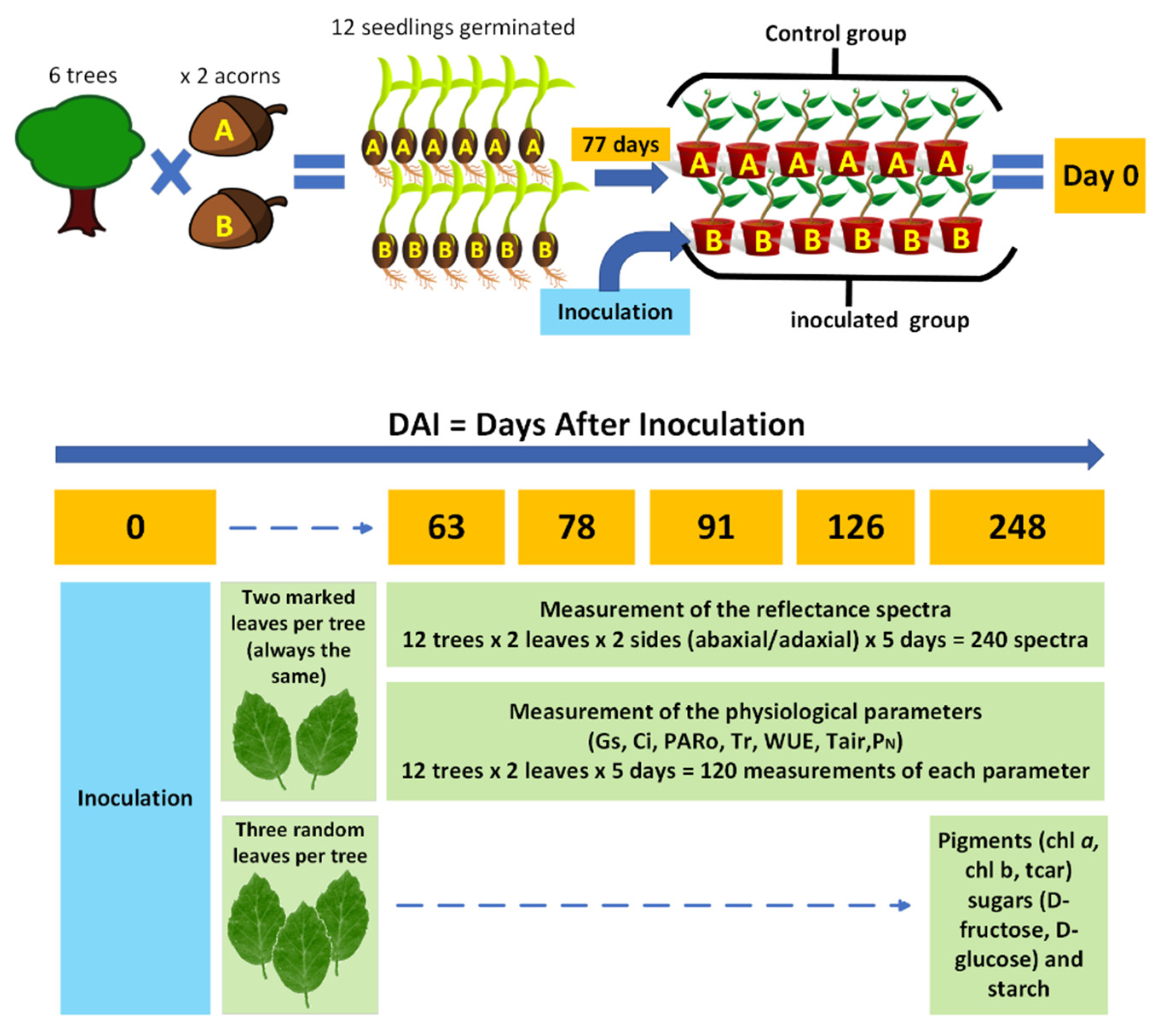
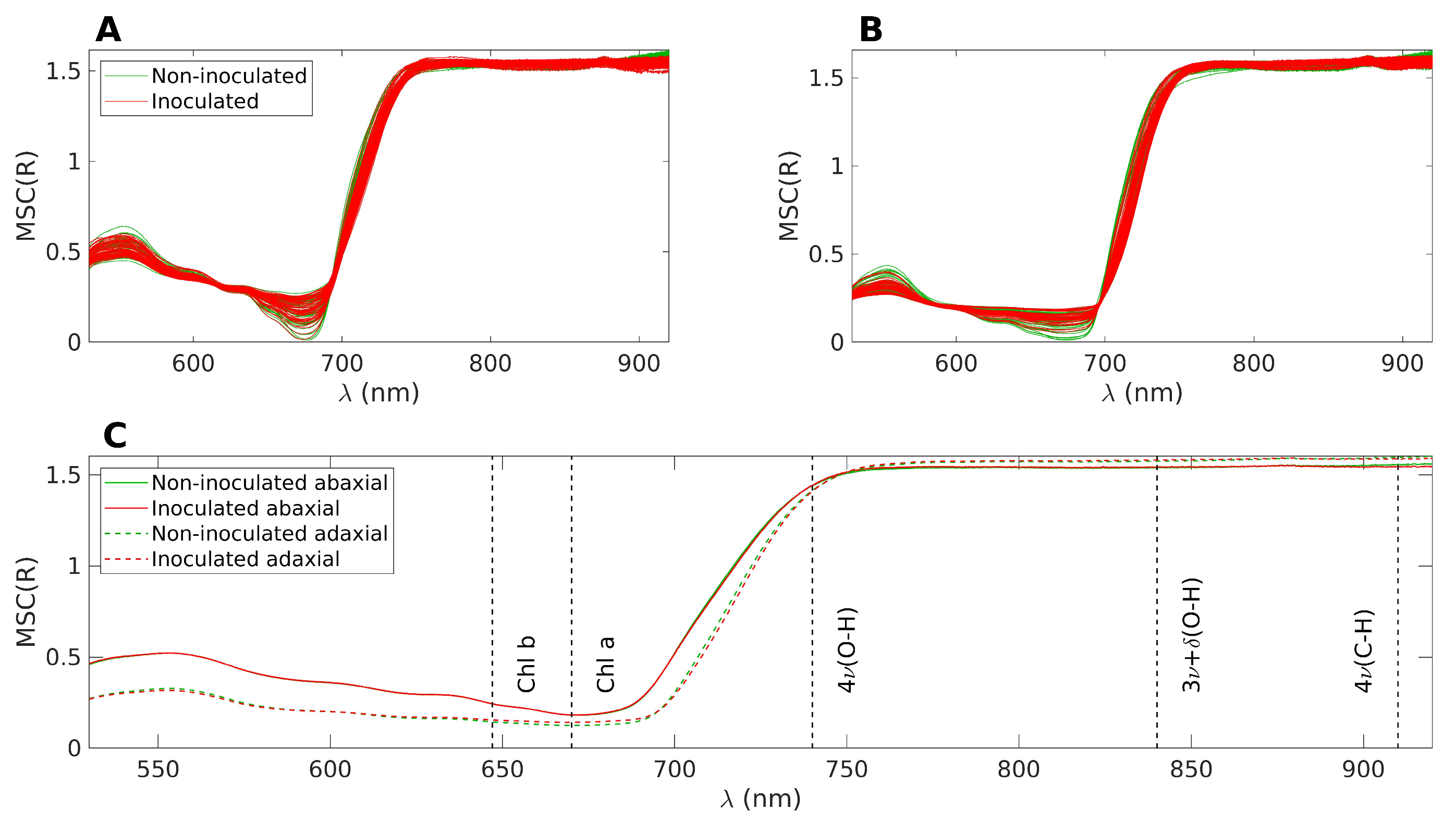

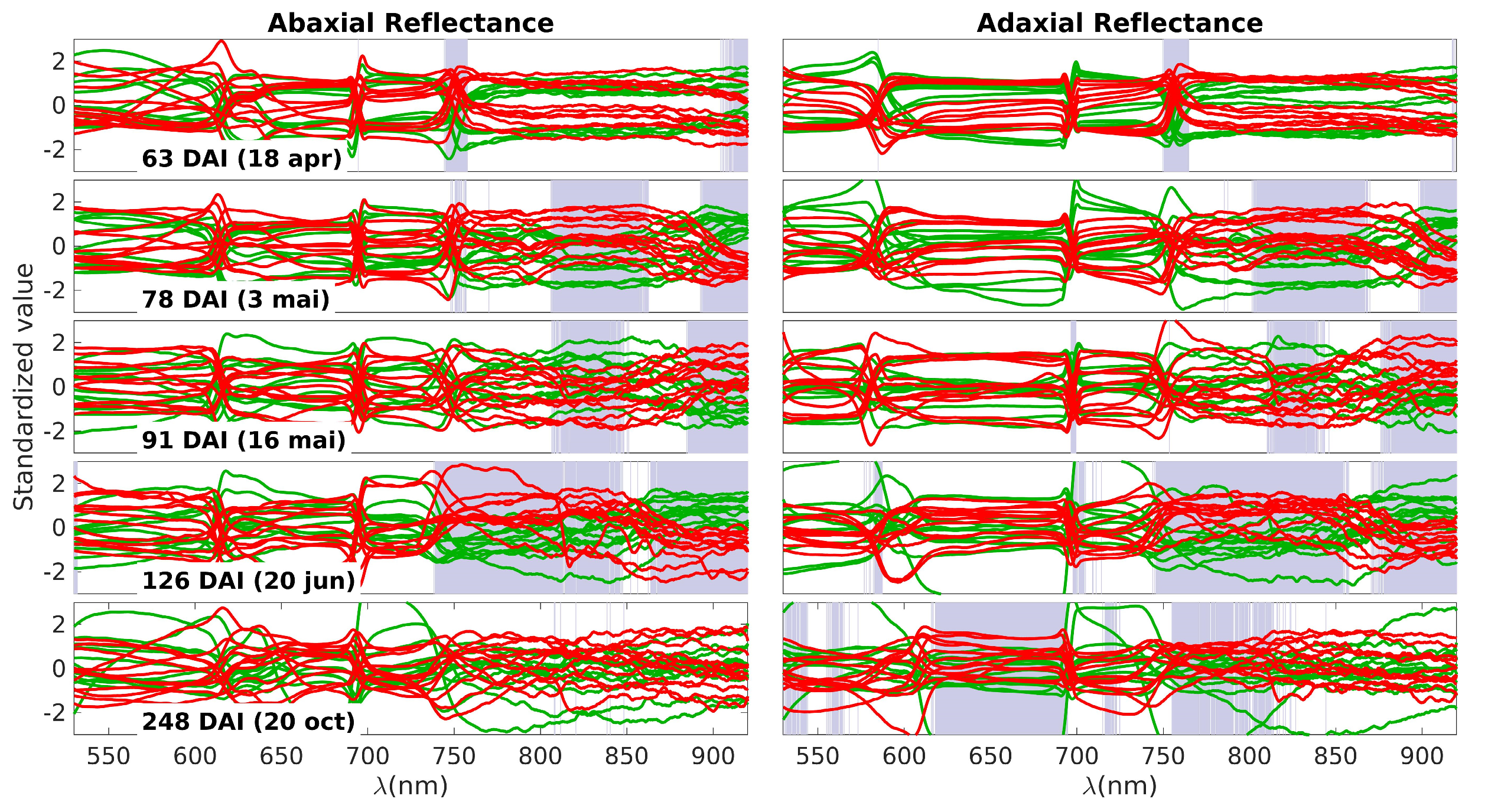
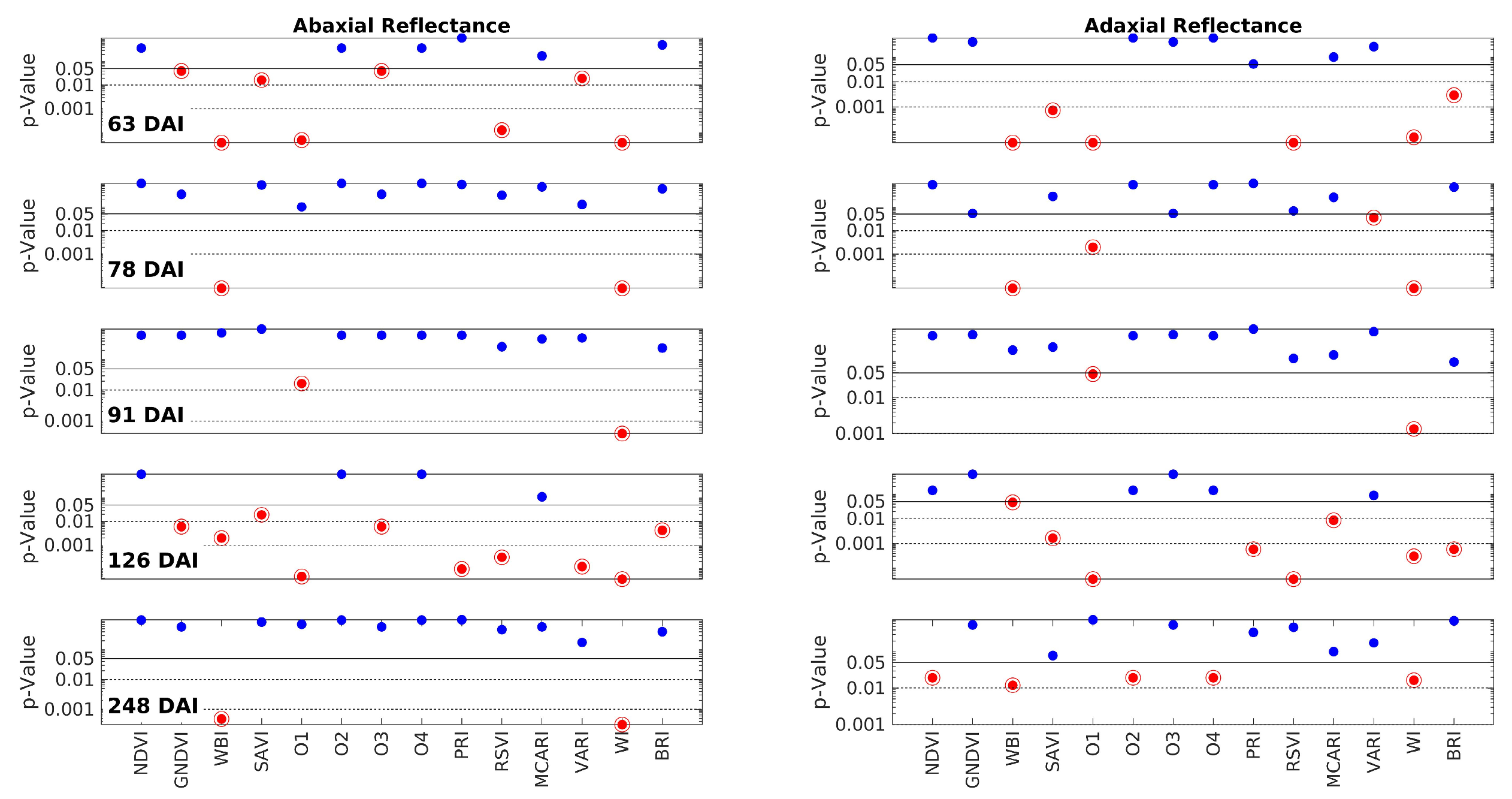
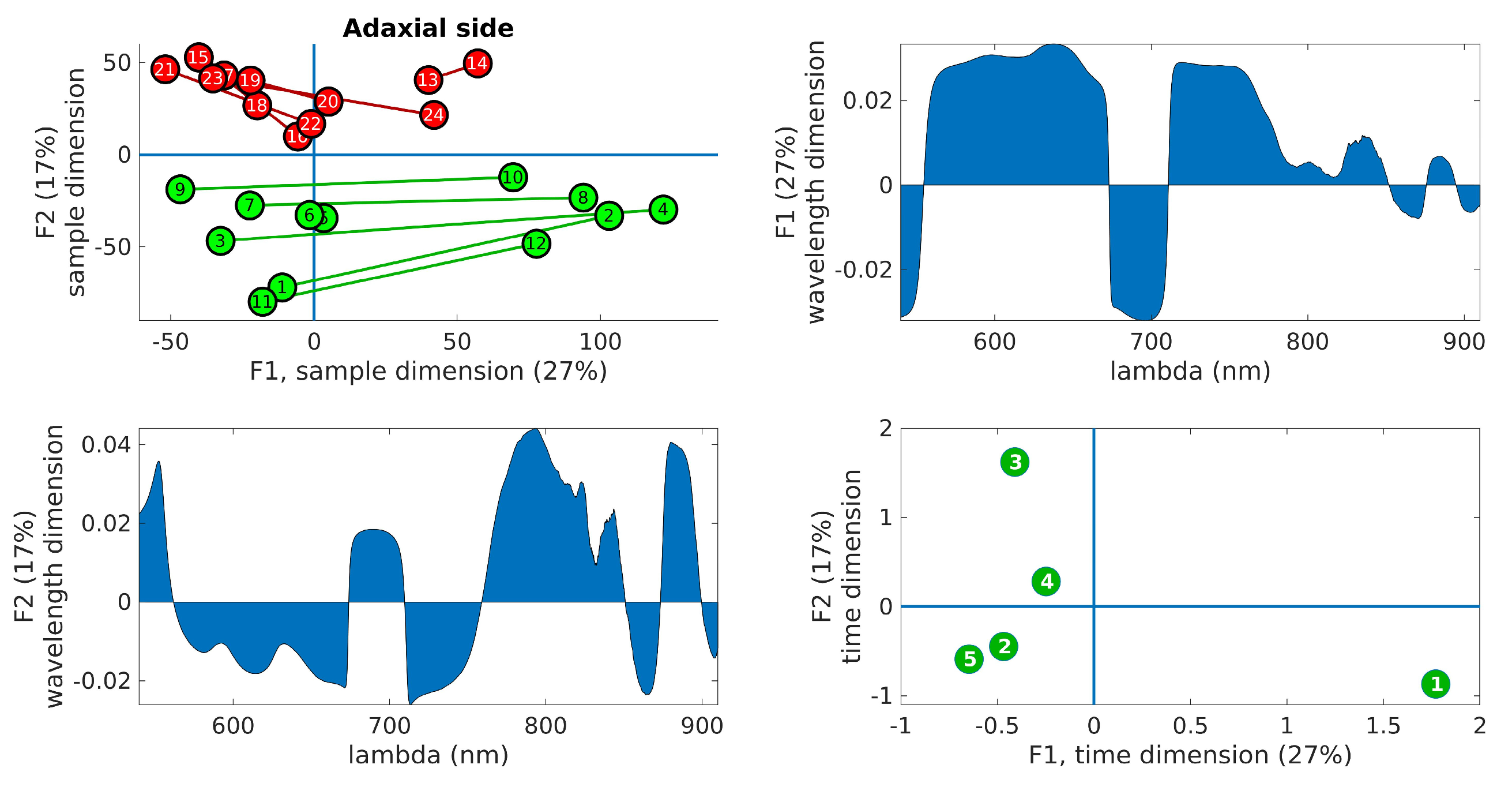

| Name | Formula * | Reference |
|---|---|---|
| NDVI | (N − R)/(N + R) | [32] |
| GNDVI | (G − R)/(G + R) | [33] |
| WBI | R950/R900 | [34] |
| SAVI | [(1 + L)(N − R)]/(N + R + L), L = 0.5 | [35] |
| O1 | N − aR, a = 1 | [36] |
| O2 | R/N | [37] |
| O3 | G/R | [38] |
| O4 | N/R | [39] |
| PRI | (R531 − R570)/(R531 + R570) | [40] |
| RSVI | (R714 + R752)/2 − R733 | [41] |
| MCARI | [(R700 − R670) − 0.2(R700 − R500)] × R700/R670 | [42] |
| VARI | (G − R)/(G + R − B) | [35] |
| WI | R900/R970 | [34] |
| BRI | (1/R550 − 1/R700)/N | [43] |
| Name | % Detection * |
|---|---|
| NDVI | 10 |
| GNDVI | 20 |
| WBI | 80 |
| SAVI | 40 |
| O1 | 70 |
| O2 | 10 |
| O3 | 20 |
| O4 | 10 |
| PRI | 20 |
| RSVI | 40 |
| MCARI | 10 |
| VARI | 30 |
| WI | 100 |
| BRI | 30 |
| Physiological Parameters * | Control Samples (N = 6 × 2 × 5) | Inoculated Samples (N = 6 × 2 × 5) | ||
|---|---|---|---|---|
| Mean | Std. Deviation | Mean | Std. Deviation | |
| PN (µmol CO2 m−2s−1) | 7.76 | 0.65 | 9.41 | 0.47 |
| gs (µmol m−2s−1) | 0.1008 | 0.0094 | 0.0895 | 0.0081 |
| Ci (µmol CO2 mol−1) | 240.59 | 14.62 | 227.24 | 14.05 |
| Tr (mmol H2O m−2s−1) | 2.8692 | 0.3566 | 2.7638 | 0.3180 |
| WUE (µmol CO2/mmol H2O) | 3.62 | 0.30 | 3.63 | 0.27 |
| Environmental conditions ** | Control Samples | Inoculated Samples | ||
| Tair (°C) | 27.83 | 0.37 | 30.11 | 0.34 |
| PARo (µE m−2s−1) | 1485.917 | 117.3678 | 1512.050 | 117.2944 |
| RH (%) | 35.24 | 1.78 | 30.39 | 1.66 |
| VPDL (kPa) | 2.60 | 0.13 | 3.19 | 0.14 |
| Pigments | Control Samples | Inoculated Samples | ||
|---|---|---|---|---|
| Mean | Std. Deviation | Mean | Std. Deviation | |
| Chl a (mg/cm2) | 0.0454 | 0.0131 | 0.0435 | 0.0047 |
| Chl b (mg/cm2) | 0.0082 | 0.0033 | 0.0091 | 0.0014 |
| tcar (mg/cm2) | 0.0120 | 0.0033 | 0.0122 | 0.0018 |
| Pigment ratios/combinations | Control samples | Inoculated samples | ||
| Chl a + b (mg/cm2) | 0.0536 | 0.0526 | ||
| Chl a/b | 5.5 | 4.8 | ||
| Chl a + b/tcar | 4.5 | 4.3 | ||
| Sugars | Control Samples | Inoculated Samples | ||
|---|---|---|---|---|
| Mean | Std. Deviation | Mean | Std. Deviation | |
| Glucose (mg/cm2) | 0.0265 | 0.0080 | 0.0299 | 0.0152 |
| Fructose (mg/cm2) | 0.0135 | 0.0074 | 0.0206 | 0.0191 |
| Sacarose (mg/cm2) | 0.3619 | 0.1010 | 0.3571 | 0.0623 |
| Starch (mg/cm2) | 0.1198 | 0.0558 | 0.1341 | 0.0862 |
Disclaimer/Publisher’s Note: The statements, opinions and data contained in all publications are solely those of the individual author(s) and contributor(s) and not of MDPI and/or the editor(s). MDPI and/or the editor(s) disclaim responsibility for any injury to people or property resulting from any ideas, methods, instructions or products referred to in the content. |
© 2023 by the authors. Licensee MDPI, Basel, Switzerland. This article is an open access article distributed under the terms and conditions of the Creative Commons Attribution (CC BY) license (https://creativecommons.org/licenses/by/4.0/).
Share and Cite
Guerra, R.; Pires, R.; Brázio, A.; Cavaco, A.M.; Schütz, G.; Coelho, A.C. Spectral Analysis, Biocompounds, and Physiological Assessment of Cork Oak Leaves: Unveiling the Interaction with Phytophthora cinnamomi and Beyond. Forests 2023, 14, 1663. https://doi.org/10.3390/f14081663
Guerra R, Pires R, Brázio A, Cavaco AM, Schütz G, Coelho AC. Spectral Analysis, Biocompounds, and Physiological Assessment of Cork Oak Leaves: Unveiling the Interaction with Phytophthora cinnamomi and Beyond. Forests. 2023; 14(8):1663. https://doi.org/10.3390/f14081663
Chicago/Turabian StyleGuerra, Rui, Rosa Pires, António Brázio, Ana Margarida Cavaco, Gabriela Schütz, and Ana Cristina Coelho. 2023. "Spectral Analysis, Biocompounds, and Physiological Assessment of Cork Oak Leaves: Unveiling the Interaction with Phytophthora cinnamomi and Beyond" Forests 14, no. 8: 1663. https://doi.org/10.3390/f14081663
APA StyleGuerra, R., Pires, R., Brázio, A., Cavaco, A. M., Schütz, G., & Coelho, A. C. (2023). Spectral Analysis, Biocompounds, and Physiological Assessment of Cork Oak Leaves: Unveiling the Interaction with Phytophthora cinnamomi and Beyond. Forests, 14(8), 1663. https://doi.org/10.3390/f14081663







